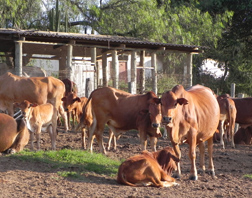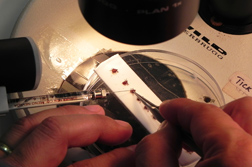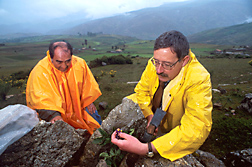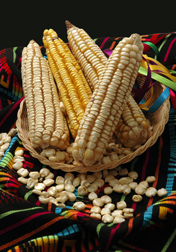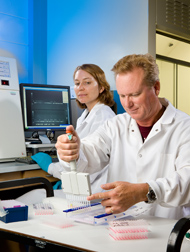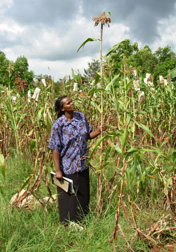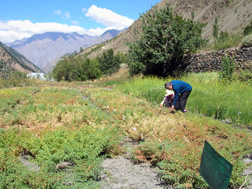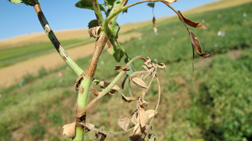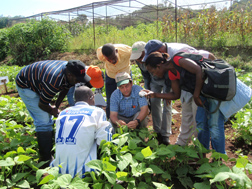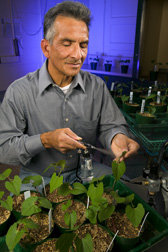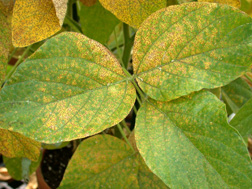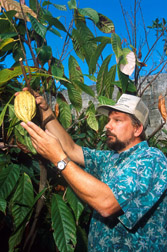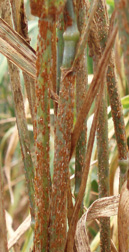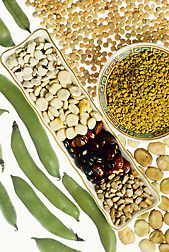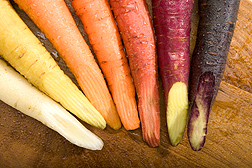ARS and CGIAR
Working To Provide International Food Security
There is an old saying that it takes a village to raise a child. Well, it takes a planet to feed all of them. While each continent, country, and region faces unique agricultural challenges, it will take a committed global focus to meet those challenges. The Agricultural Research Service (ARS) and the Consultative Group on International Agricultural Research (CGIAR) collaborate again and again to do just that. CGIAR is a network of 15 international agricultural research centers, several of which are featured below.
Solutions for Serious Animal Diseases
Rift Valley fever, foot-and-mouth disease, and East Coast fever are some of the diseases that harm livestock and threaten the livelihood of farmers in developing nations like those of sub-Saharan Africa. The challenge of keeping these animals alive, healthy, and productive is one that’s being addressed through worldwide partnerships. Scientists at ARS and CGIAR’s International Livestock Research Institute (ILRI) in Nairobi, Kenya, are working together to help producers increase and sustain their livestock and farm productivity.
Laying the groundwork for an East Coast fever vaccine
Developing a vaccine that protects cattle against East Coast fever (ECF), a devastating disease in eastern and central Africa, is a team effort for scientists at ILRI and ARS’s Animal Disease Research Unit (ADRU) in Pullman, Washington.
Researchers are in their fifth year of a collaborative project, “Combination Vaccines for Tick-Borne Diseases,” which involves studying the tick, Rhipicephalus appendiculatus, that transmits Theileria parva, the parasite responsible for ECF.
“The focus of our work in the United States is Texas cattle fever, and in Kenya the focus is East Coast fever,” says ARS entomologist Glen Scoles. “Because these parasites and the ticks that transmit them are so similar, proteins we identify in one system can also be studied in the other.”
A vaccine for ECF could lead to a vaccine for Texas cattle fever, he says.
|
|
“It is important that the global community works together to control diseases that limit food and fiber production, and East Coast fever is one of those diseases,” says ADRU’s research leader Don Knowles. “Although we currently control most such diseases in the United States, what we learn from this collaboration will help prevent parasitic diseases here as well as in other countries.”
Scoles, Knowles, and Massaro Ueti, an ADRU veterinary medical officer, teamed up with ILRI scientists to develop a polymerase chain reaction test that detects parasite DNA in ticks to quantify the level of infection. Two strains of nymphal ticks, developed at ILRI to have different Theileria parva susceptibilities, were allowed to feed simultaneously on infected calves and compared. The Muguga strain had a low level of parasitic infection, and the Kiambu strain was highly susceptible.
The next step will be to uncover the genetic basis for the difference between the strains and identify tick proteins that are produced in response to infection. These might be good targets for a vaccine that would help control both the parasite and the ticks that transmit them.
“A similar approach can be applied to the tick that transmits Texas cattle fever,” Scoles says.
Preparing for Rift Valley fever vaccine trials
Scientists at the ARS Center for Grain and Animal Health Research (CGAHR) in Manhattan, Kansas, and international institutions in sub-Saharan Africa are developing and evaluating control strategies for diseases like Rift Valley fever (RVF), which is transmitted by mosquitoes to animals and humans.
A viral disease mainly in ruminant animals, RVF causes abortions in livestock, high mortality in young animals, and can be lethal in humans. Symptoms include fever, jaundice, and diarrhea.
CGAHR scientists at the Arthropod-Borne Animal Disease Research Unit and colleagues at Kenya Medical Research Institute (KEMRI) and Kenya Agriculture Research Institute (KARI) are teaming up with scientists at ILRI to help determine how to control RVF. At KEMRI, mosquito populations are being studied for potential RVF activity between outbreaks. At KARI, researchers are building infrastructure and developing tools to conduct large RVF vaccine trials and diagnostic evaluations.
“The next stage is to actually conduct vaccine studies using ILRI researchers’ expertise in immunology,” says CGAHR microbiologist William Wilson.
Testing new methods to track FMDV
A novel tool that tracks the adaptive immune response to vaccines for foot-and-mouth disease virus (FMDV) is being applied to cattle at ARS’s Foreign Animal Disease Research Unit at Plum Island Animal Disease Center in Orient Point, New York, and at ILRI.
Foot-and-mouth disease is an acute, highly contagious infection that threatens the health and economic value of livestock worldwide. Though the disease hasn’t been seen in the United States since the 1920s, recent outbreaks have been reported in Japan, Bulgaria, and South Korea.
The new technology, based on major histocompatibility complex (MHC) tetramers, was first developed in mice and humans and has only recently been applied to livestock, says ARS microbiologist William Golde. For the first time, scientists can follow more complicated T cell immune responses in addition to B cells.
“Antigens for virus-specific T cells are actually very small peptides of viral proteins that are present in the MHC molecules, which are the tissue molecules,” Golde says. “The technology is based on typing cattle, just like you type a human for an organ transplant and know exactly which molecules you’re working with. The combination of MHC protein and viral peptide are made into tetramers that can then identify the responding T cell.”
The goal is to demonstrate that MHC tetramers can be applied to vaccine development in cattle and create tools for working with livestock diseases, says Golde, who has used the technique in pigs. In those experiments, pigs were vaccinated either with a vaccine targeting T cells or another targeting B cells and then compared. Results showed that by redesigning vaccines to target T cells, a different kind of immune response to FMDV could be induced.
Golde is working with ILRI researchers to apply these tools to other important cattle diseases in Africa, like East Coast fever. Further, he is working to import cells producing monoclonal antibodies specific for bovine proteins used for analyzing the immune response in cattle. These were prepared at ILRI.
“These reagents will be imported, tested for safety, and used in further research at Plum Island to study the response to FMD,” Golde says. “Once safety tested, they will then become available to the North American research community.”
Mapping the genome of sheep for parasite resistance
Identifying genes in sheep, goats, and cattle that increase tolerance to gastrointestinal (GI) parasites and improve production of grazing animals is another collaborative effort of ARS and ILRI scientists.
These parasites cause economic and production losses. Infected sheep suffer from diarrhea, weight loss, and anemia, and some die.
The team is the first to detect quantitative trait loci (QTLs) in a double-backcross population derived from native sheep adapted to the extreme conditions of East Africa.
Researchers started a breeding program at ILRI more than 10 years ago to create a resource population for mapping regions of the ovine genome that control resistance to GI nematode parasites predominant to African regions. Breeding started with creating hybrid rams by mating a GI parasite-tolerant breed—Red Maasai—to a more susceptible breed—Dorper. Six of the hybrid ram offspring were then bred to either Red Maasai or Dorper ewes to complete the backcross.
“We genotyped 20 percent of the progeny of those matings to map QTLs affecting parasite resistance traits,” says Tad Sonstegard, an ARS geneticist at the Henry A. Wallace Beltsville [Maryland] Agricultural Research Center. “Some of the sheep were 75 percent Red Maasai, and some were 75 percent Dorper.”
Parasite indicators—blood packed-cell volume and fecal egg count—were collected on a weekly basis for 3 months from 1,064 lambs grazing on GI-nematode-infected pastures. Average packed-cell volume, which indicates whether sheep are anemic from blood-feeding parasites, and average fecal egg count, which indicates worm load and fecundity, were used to select lambs for genotyping.
Significant QTLs for average fecal egg count and packed-cell volume were detected on chromosomes 3, 6, 14, and 22.
In a follow-up study, scientists plan to genotype the same animals again using the OvineSNP50, which interrogates more than 50,000 locations in the genome, says Sonstegard. The previous study looked at only 200 locations.
“If we can identify some of the genes that increase tolerance to parasites or figure out the best combination of Dorper and Red Maasai from a genome-composition view, we can increase production, and maintain that adaptability to parasites,” Sonstegard says. “This ultimately leads to better germplasm, which leads to better global food security.”
Genetics Provide the Base for Crop Production
Crops such as potatoes, corn, wheat, rice, beans, and more are the staples that feed the world. For developing nations, they are often critical for survival. The task of providing varieties of these crops that can sustainably supply the needed nutrients is a high priority for agricultural research. Several of the CGIAR centers focus on these crops and others.
Partnerships for potatoes
In developing countries, the potato is a vital source of nutrients for humans. Pinpointing a potato species’ true origin can help scientists find genes needed to improve potato production.
ARS researchers and their counterparts at the International Potato Center (CIP) in Lima, Peru, are combining geographic information with computer-based tools to analyze distribution data of wild potato species, which are native to the Americas.
Until recently, wild potatoes were not known to spread outside of their native range, which is from the southwestern United States to central Chile and adjacent countries.
Botanist David Spooner at ARS’s Vegetable Crops Research Unit in Madison, Wisconsin, and his CIP colleagues found that the wild potato species Solanum chacoense has become established in seven nonnative sites around the world, including parts of China, England, Peru, Argentina, the United States, and New Zealand. They also found that a cultivated potato, S. tuberosum, is now established in the wild in Hawaii and Africa.
“A technique called ‘environmental modeling’ was used to show other places where S. chacoense might spread,” Spooner says. “The technology enables us to look at relationships between taxonomy and diversity and at locations and habitats where most species are found.”
Boosting beta-carotene in corn
Corn and wheat are eaten in some form or another by just about everyone on the planet. Scientists affiliated with the International Maize and Wheat Improvement Center (CIMMYT) near Mexico City, Mexico, are focused on increasing the productivity of maize and wheat production systems to ensure global food security and reduce poverty.
In many developing areas of the world, corn is a staple food. In areas where most daily calories consumed come from corn, people can suffer blindness and other serious health issues because of a lack of vitamin A.
Cultivated corn does contain some carotenoids, like beta-carotene, which are converted to vitamin A in the body. Raising the concentration of beta-carotene in corn would help fight vitamin A deficiency in those areas where other sources of carotenoids in the diet are severely limited.
ARS plant geneticists Ed Buckler of the Plant, Soil, and Nutrition Research Unit in Ithaca, New York, and Marilyn Warburton of the Corn Host Plant Resistance Research Unit in Mississippi State, Mississippi, have worked to identify the genes that different corn varieties use to make beta-carotene.
Warburton and Buckler analyzed many of the high beta-carotene corn lines in the CIMMYT genebank and from CIMMYT and U.S. maize breeders. Focusing on the biochemical pathway responsible for producing carotenoids in corn, they have identified which genes would increase the concentration of beta-carotene most efficiently. The most promising type of one of these genes came from tropical corn germplasm, while the best form of another gene in the same pathway came from temperate corn. “By knowing which temperate U.S. corn variety to cross with which tropical corn variety, we could create a variety that provided much higher beta-carotene levels than would have been identified using traditional plant-breeding methods,” says Warburton. (See “Boosting Vitamin A Levels in Corn To Fight Hunger,” Agricultural Research, May/June 2010.)
Improving yield and drought resistance
Buckler has also been working on finding genetic markers for accelerating yield improvement and drought resistance. “We have a National Science Foundation/Gates Foundation funded project with the CGIAR centers to reduce the cost of genotyping and make finding the markers less expensive than growing out the varieties in field trials,” says Buckler. “We are making good progress on that.”
|
|
“We are about to start genotyping all the important breeding lines of corn and sorghum found throughout sub-Saharan Africa over the next few months,” says Buckler. “The genotyping data will be posted on public websites, including the CGIAR public website. But the real value is for breeders to take their data on yield and performance in various environments and find out if they can apply the genotyping data to make useful outcome predictions.”
Making this process faster and less expensive is important. “Imagine if every time you want to know whether or not a corn variety meets your needs, you must grow it and measure it in 10 environments. This can cost hundreds of dollars. For $10 or $20, we can genotype that line and predict whether it will serve the breeder’s needs,” says Buckler. This can help narrow the field of potential candidate corn varieties. “Of the thousands of potential corn lines, we can focus on the 10 percent that are likely to be the best. This saves everyone effort and time,” says Buckler.
“We are also involved with CIMMYT in the survey of all the corn varieties called ‘landraces’—traditional or heirloom varieties that farmers grew before modern breeding techniques were applied. These landraces have been adapted to grow in specific locations all over North and South America. For the first time, we will analyze them systematically to try to start mining out the genetic variation by genotyping them,” says Buckler.
Sharing rice germplasm to help feed the world
|
|
Rice is a staple in many diets across the globe, and ARS scientists have forged collaborations with their international counterparts to help enhance rice production. That, of course, means navigating various challenges growers face, such as diseases. ARS scientists at the Dale Bumpers National Rice Research Center (DB-NRRC) in Stuttgart, Arkansas, collaborate with scientists at the International Rice Research Institute (IRRI) to evaluate rice germplasm and improve disease resistance, yield, and grain quality. IRRI is headquartered in the Philippines.
It helps to know what different rice varieties have to offer for breeders in particular geographical regions. Rice genetic resources are stored in large germplasm banks around the world, such as the Svalbard Global Seed Vault in Norway, and those in the United States and the Philippines. Germplasm is also stored and studied in smaller collections at various research locations. ARS plant geneticist Georgia Eizenga has been exploring the genetics of rice varieties housed in the IRRI germplasm bank. “IRRI has more than 112,000 rice accessions, making it the largest collection in the world,” says Eizenga. By comparison, the United States has nearly 19,000 rice accessions and supplied 400 of these to develop a “rice diversity panel.” The diversity panel is a set of rice varieties that that have been collected from various stages in history and from different countries. Some are wild rice types that have been collected in different environments, and others are varieties recently developed by breeders.
“We grow the diversity panel and develop genetic markers to find out which genes are responsible for particular traits,” explains Eizenga. “The first complete rice genome sequence was for a Japanese cultivar, Nipponbare, which serves as the reference genome.” By comparing different rice varieties against the Nipponbare sequence, researchers can determine which markers are associated with specific traits, like flowering time, seed size, leaf length, and even how sticky the grains are after cooking. These visible traits are called “phenotypic traits.” Phenotypic data, along with genetic markers, can provide information about which genes govern certain traits. This enables researchers to more efficiently conduct genetic research into important agronomic traits such as disease resistance, yield, and quality.
Examining rice genes at the molecular level
ARS plant pathologist Yulin Jia, also at DB-NRRC, researches the molecular relationship between rice and the fungi responsible for the diseases rice blast and sheath blight. “I visited IRRI a few years ago and was able to bring back more than 100 lines that contained different genes that confer resistance to the blast fungus,” says Jia. “Similarly, IRRI scientists have imported rice germplasm from the ARS collection for their research. Some of this germplasm has shown some resistance to sheath blight strains that occur in their environment.”
Genes are constantly changing in order to survive, and over the years the genes in rice and fungi have co-evolved. “Resistance is relative to the specific pathogens. For instance, not all humans are immune to flu viruses, because new strains of flu emerge constantly. That is also true for fungal strains and the rice varieties they infect,” explains Jia. “So as time goes by, the old resistance genes may not work against the new fungal strains.”
The work has certainly paid off. “We characterized the molecular mechanisms of rice blast resistance—how it works and how resistance genes evolved. We have also mapped two major blast-resistance genes from a rice cultivar from China,” says Jia.
New rice varieties
Rice quality is also an area of interest to breeders, growers, and researchers. ARS scientists in Arkansas and Texas, in collaboration with researchers at Texas A&M University, University of Arkansas, Clemson University, and IRRI, developed new varieties that offer new options for U.S. growers and expanded market opportunities for the U.S. rice industry.
Although conventional long-grain varieties are grown on more than 75 percent of the rice acreage in the United States, there is interest in developing cultivars that possess specific qualities required for certain value-added markets.
The variety JES is an aromatic, soft-cooking, long-grain rice suited for the market predominantly filled by imports. A jasmine-style rice, JES has greater yield, is 5 inches shorter, and matures a week earlier than Jasmine 85, a variety currently grown for this market.
Charleston Gold, another aromatic rice, was derived from Carolina Gold (an heirloom variety that was the basis for establishing the U.S. rice industry) and genetic material from the Philippines and India. It has excellent yield, disease resistance, and cooking quality. This cultivar may lend itself well to production under organic conditions and will be used by the historically authentic cuisine market in the Carolinas.
Breeding for disease-resistant chickpeas and lentils
Scientists at ARS’s Grain Legume Genetics and Physiology Research Unit in Pullman, Washington, and the International Center for Agricultural Research in Dry Areas (ICARDA) in Aleppo, Syria, are exchanging breeding lines of germplasm to develop disease resistance and other agronomic characteristics.
“We’re incorporating a lentil collection from ICARDA into our breeding program as a source of winter hardiness—cold tolerance—and virus resistance,” says George Vandemark, ARS geneticist and research leader at Pullman. In turn, ARS is providing ICARDA with a special chickpea population.
“We developed a population of mutated chickpea lines, and they’re really valuable genetic material,” Vandemark says. “We don’t have the resources to propagate the population, so our partners at ICARDA are going to increase it for us. They’ll grow, harvest, clean, and store them.”
Researchers at Pullman also work with colleagues at the International Crops Research Institute for the Semi-Arid Tropics in Patancheru, India, on studies that involve testing pest-resistant chickpeas. (See “Help for the Common Bean: Genetic Solutions for Legume Problems,” Agricultural Research, May/June 2010.)
|
|
Other work includes cooperative research with ICARDA that focuses on inheritance and mapping of lentil genes for resistance to rust and Stemphylium blight, two important diseases of lentil in Southeast Asia, says Weidong Chen, ARS plant pathologist at Pullman.
“We are trying to find DNA markers linked to genes for resistance to the diseases,” Chen says. “We don’t have lentil rust in the United States, but Stemphylium blight has been seen in North Dakota, other Northern Plains states, and adjacent Canada. So we have developed the tools to identify some of the candidate DNA markers for resistance.”
Finding genes to help bean growers
The International Center for Tropical Agriculture (CIAT) is headquartered in Cali, Colombia, and focuses on developing eco-friendly methods of producing crops. Plant pathologist Marcial Pastor-Corrales of the Soybean Genomics and Improvement Research Unit in Beltsville, Maryland, worked at CIAT for 17 years before coming to ARS and maintains close collaborative relationships with his former colleagues. Pastor-Corrales is working on improving common bean production, with an emphasis on discovering and incorporating genes for resistance to diseases, particularly common bean and soybean rusts. Common bean rust is a major constraint to bean production in most countries where dry and snap beans are produced, especially in eastern and southern Africa and Latin America.
|
|
“The CIAT Bean Germplasm Bank has the largest and most diverse common bean collection in the world, with some 36,000 accessions,” says Pastor-Corrales. This diversity may be just what is needed to help with pathogens that are moving around the globe. “The common bean rust is a highly variable pathogen that is important worldwide. The various races of this pathogen change from one year to another, so we are always looking for new rust-resistant genes for common bean,” he says.
In 2007, two new races of the common bean rust pathogen appeared in the United States, and many dry bean cultivars were susceptible to them. “We have found many new genes for resistance to several diseases, including common bean rust, from CIAT accessions. These are potentially very valuable,” says Pastor-Corrales. “These collaborations can result in preventing problems in the United States and enhancing production and making it safer and more sustainable in other countries.”
|
|
In the 2008-2009 growing season, the U.S. farm value of soybean production was $29.6 billion. A potential threat to this crop is the soybean rust pathogen, which arrived here in 2004. “Working with scientists from the USDA-ARS Foreign Disease-Weed Science Research Unit, we tested germplasm obtained from CIAT and found that some common dry beans were resistant to soybean rust,” says Pastor-Corrales. “Because the soybean rust pathogen also infects common beans and other legumes, 16 lines of common dry beans were tested with 6 isolates of the soybean rust pathogen from Asia, Africa, and Latin America. We found 5 dry bean cultivars that were highly resistant to soybean rust. Wild accessions have more genetic diversity, so we would like to discover more resistance genes that can confer soybean rust resistance from these wild varieties to common beans and soybeans.”
Meanwhile, in Puerto Rico, ARS plant geneticist Timothy Porch of the Tropical Agriculture Research Station in Mayagüez is working with CIAT scientist Rowand Chirwa and with scientists at the University of Puerto Rico and the Ministry of Agriculture in Angola on developing resistance to prevalent diseases in common bean for Angola. “The work began in 2007 and focuses on developing lines, for future cultivar release, with resistance to angular leaf spot, bean common mosaic virus, and common bacterial blight. There is a graduate student from Angola at the University of Puerto Rico performing this work on disease resistance in common bean and another graduate student studying cowpea diversity,” explains Porch.
“We are using CIAT germplasm to develop and release lines with root rot resistance and heat and drought tolerance that will be used to improve U.S. varieties of common bean,” says Porch. “We are working on introducing novel traits and on converting tropical varieties to types that can be grown in the temperate U.S. region. This would require introducing photoperiod insensitivity to photoperiod-sensitive tropical type beans.” That way, beans previously adapted to the 12-hour day-length of the Tropics will also be productive in the longer 16- to 18-hour photoperiods in the United States.
Collecting lentils from Nepal
Lentils are an important export crop for the United States and important food for the people of many nations. Geneticist Clarice Coyne of the ARS Plant Germplasm Introduction and Testing Research Unit in Pullman, Washington, manages lentil germplasm at the unit, which is also known as the Western Regional Plant Introduction Station (WRPIS). There are 3,247 lentil accessions at Pullman, but only 13 accessions are of lentil from Nepal.
In association with Ashutosh Sarker, a senior scientist with ICARDA, Coyne has developed a joint proposal to boost the number of lentil accessions in the WRPIS collection. An exploration trip is in the planning stages to collect lentil accessions from Nepal.
“We have an interest in lentil production in Nepal because they grow lentils at a high elevation. This means they will grow at a lower temperature than other lentils,” says Coyne. “These plants may be adapted to colder temperatures, which would be helpful to lentil growers in the U.S. Pacific Northwest.” Lentils could be grown as a fall-sown crop in Washington State. That would also help with soil erosion, which is a problem during the winter months.
It is important to collaborate with ICARDA because they have the expertise necessary to conduct a successful exploration trip in Nepal. “Their experts know where to find the lentils and they know their growing habits,” says Coyne. “Also, a portion of the proposed funding would go to Nepal in order to develop their national germplasm collection.”
|
|
Thwarting diseases of cacao
Cacao is the source of chocolate. Unfortunately, cacao is under attack by diseases like witches’ broom, frosty pod, and black pod. ARS geneticist Raymond Schnell at the Subtropical Horticultural Research Station in Miami, Florida, is working with an international consortium to document genes and genetic markers that might lend resistance to these and, potentially, other diseases of cacao.
Working with the International Institute of Tropical Agriculture, Schnell and other international collaborators have developed 6,000 single nucleotide polymorphism (SNP) genetic markers, which are being used for marker-assisted breeding (MAB). The goal of MAB is to find SNPs or microsatellite markers associated with resistance to these diseases. Markers associated with resistance are then used to select for new cacao varieties with resistance. Using these markers greatly increases the efficiency of traditional breeding. Cacao cultivars that are resistant to these diseases will ensure that there will be a plentiful supply of cocoa beans for the confection industry.
|
|
In the breeding effort, Schnell and his collaborators have field trials under way in West Africa in Ghana, Cameroon, Nigeria, and Cote d’Ivoire. Field trials are also located in Ecuador, Brazil, Costa Rica, and Papua New Guinea.
The battle against Ug99 continues
The fight against a menacing strain of wheat stem rust—Ug99—is gaining momentum. The U.S. Agency for International Development is providing Feed the Future resources through the Norman Borlaug Commemorative Research Initiative for ARS to build a greenhouse at the Cereal Disease Laboratory (CDL) in St. Paul, Minnesota, as part of a collaborative effort to develop rust-resistant varieties. A groundbreaking ceremony was held in June 2011.
The greenhouse will greatly increase CDL scientists’ ability to identify foreign wheat rust isolates from CGIAR centers, says CDL research leader Marty Carson. Research on Ug99 will be conducted under contained and authorized conditions.
|
|
Ug99 was discovered in Uganda more than a decade ago and has quickly spread throughout East Africa, Asia, and the Middle East. (See “International Wheat and Barley Screening Collaboration Helps Uncover Stem Rust-Resistant Material,” Agricultural Research, February 2010.)
The disease now threatens food security in Pakistan and Afghanistan. ARS scientists will use the new greenhouse facility to help identify and verify unknown rust isolates and develop adapted rust-resistant varieties for Pakistan, which can also be used in Afghanistan, in partnership with CGIAR centers.
Other research on rust protection for wheat continues at ARS labs in Raleigh, North Carolina, and Pullman, Washington. (See “ARS Wheat Resistance Roundup,” Agricultural Research, May/June 2010.)
“We need combinations of genes and more durable genes to protect wheat for years to come from these rusts,” says Kay Simmons, deputy administrator of ARS’s crop production and protection national programs. “That’s why collaborative work between ARS wheat pathologists and geneticists with CGIAR centers is so important.”
Field trials in Kenya to screen for resistance are vital to this work, according to plant pathologist Mike Bonman of the Small Grains and Potato Germplasm Research Unit in Aberdeen, Idaho.
|
|
Bonman worked at IRRI for 9 years before coming to ARS and is now working collaboratively with CIMMYT and KARI. Bonman and colleagues have screened more than 3,000 wheat landraces from the U.S. National Small Grains Collection against new races of the stem rust pathogen in the field in Kenya. A number of resistant accessions were identified and are being retested to verify their resistance. Landraces with confirmed resistance are being crossed with susceptible wheat to determine the genetic basis of the resistance.
“CIMMYT facilitates the nursery and site logistics, and ARS helps with evaluating the level of rust development in wheat varieties,” says Bonman. “Without CIMMYT it would be difficult, and my team works closely with Sridhar Bhavani, the CIMMYT coordinator in Kenya, and with wheat breeder Peter Njau and plant pathologist Ruth Waynera, both from KARI.”
“CIMMYT and KARI personnel have developed excellent procedures to promote rust disease in the nursery to enable us to evaluate which of our accessions are resistant to rust, but a lot depends on timing,” says Bonman. “Knowing exactly when to evaluate, or rate, the disease is very important because different plant materials mature at different times, and landrace materials from the U.S. collection often mature late. A postdoctoral fellow in our lab, Maria Newcomb, was recently in Kenya to rate the off-season nursery, and we depended on Sridhar, Peter, and Ruth to help us pinpoint the optimum time for her arrival.
“Our goal is to find new genes for resistance to Ug99, because the fungus overcomes many of the resistance genes we have been using for the past 50 years. This work will help Africa’s growers now and will help suppress disease and reduce damage in developing countries. It will also prepare the United States for Ug99 should it reach our shores. This research is of great mutual benefit, and I am grateful for the outstanding assistance we receive from CIMMYT and KARI.”
All of these research collaborations will help bolster food security across the globe. ARS and CGIAR will continue these endeavors for years to come.—By Sharon Durham and Sandra Avant, Agricultural Research Service Information Staff.
This research supports the USDA priority of promoting international food security and is part of multiple ARS national programs, described at www.nps.ars.usda.gov.
To reach scientists mentioned in this article, contact Sharon Durham, USDA-ARS Information Staff, 5601 Sunnyside Ave., Beltsville, MD 20705-5129; (301) 504-1611, sharon.durham@ars.usda.gov.
GRIN-Global Brings Powerful Genebank Information System to Forefront
A better system to keep track of germplasm information will soon be available worldwide, thanks to a partnership between ARS, the Global Crop Diversity Trust, and Bioversity International (a CGIAR center). The Germplasm Resources Information Network (GRIN), an online database of plant genetic resources information developed by ARS, is going global.
GRIN-Global will replace GRIN, which is used by ARS’s National Plant Germplasm System to actively manage information regarding plant genetic resources at various genebank sites. This Internet-based database system enables curators throughout the world to customize it to fit their specific needs and enables public researchers to access germplasm information and material.
|
|
“GRIN software helps curators keep track of the origins of the genetic materials they manage and their traits, properties, and inventory status—which seeds, plants, and tissues are available and how much,” says Peter Cyr, information technology specialist and project leader at ARS’s North Central Regional Plant Introduction Station in Ames, Iowa. “It also keeps track of who requests and receives seeds or plant material.”
With GRIN-Global, other nations will have the option to access a free, easy-to-use system for documenting plant germplasm and delivering that information to researchers worldwide. Each genebank will have its own local version of the GRIN-Global software, including a customizable website that can support many languages.
|
|
The system is expected to be up and running in CGIAR centers and in several national genebank systems in 2011. It will be implemented in the United States by 2012. It will enable scientists, educators, and other germplasm users to be better informed and to choose precisely the samples that best meet their needs.—By Sandra Avant, Agricultural Research Service Information Staff.
"ARS and CGIAR: Working To Provide International Food Security" was published in the October 2011 issue of Agricultural Research magazine.







